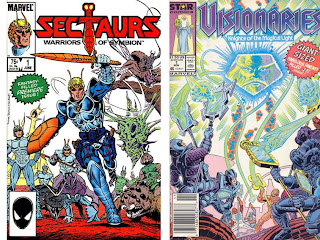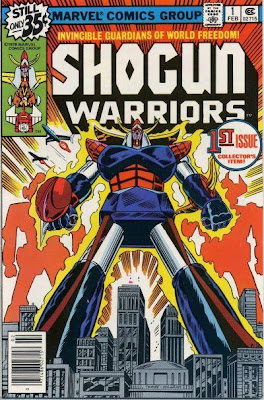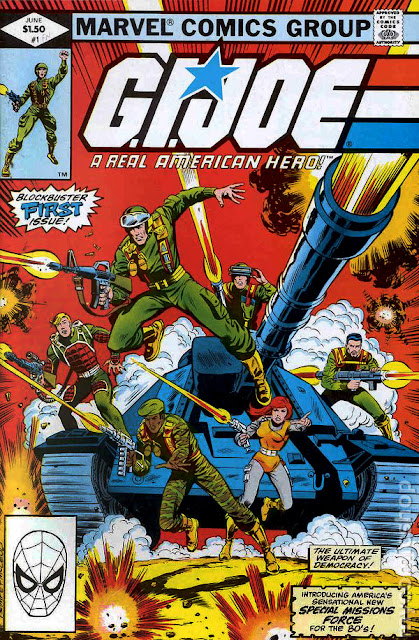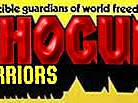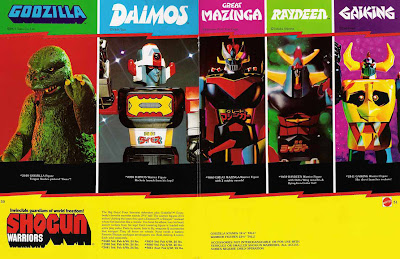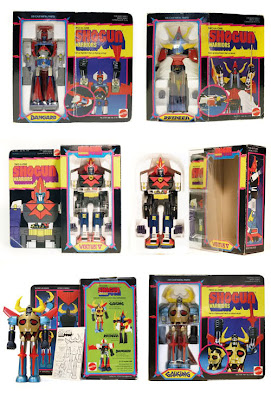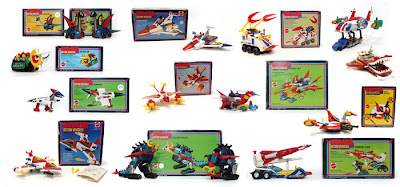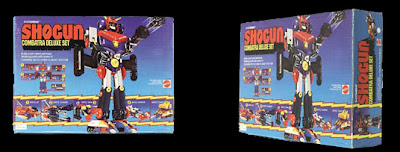A huge part of my childhood comic book collecting in the 70's and 80's were comics based on some of my favorite toy lines.
Back then, Marvel Comics was the king of translating toys/toy lines into cohesive comic book stories for the kids to follow-- especially at the time before toy companies were legally allowed to put cartoons on the air based on their toy lines.
So, now I ask you to come with me on a little trip down memory lane as I pick my Top 5 comic books based on a toy line.
Before we get started, I'll just list a few honorable mentions.
Starriors - Crap comic by Marvel. Crap toy line. Awesome Bill Sienkiewicz cover.
Sectaurs - So-so 8-issue comic by Marvel. Pretty cool toy line by Coleco (?) Really loved the cool spider puppet creatures that the figures would ride.
Visionaries - Forgetable comic by Marvel (under their STAR Comics banner). Decent toy line by Hasbo. Never really took off as either.
Crystar - Pretty good comic series by Marvel, including a guest appearance by X-Men's Nightcrawler. Not to great, but somehow awesome, toy line by Remco. To be honest, I just love any figure that is-- or has parts-- molded in transparent plastic. Plus, the idea of a knight/warrior made entirely of crystal just seemed so cool to me.
I honestly can't remember which I got first, the comics or the toys, but I know that I absolutely loved them both. Giant robots and monsters with flying fists and launching missiles? Yeah, now that's what a kid's dreams are made of!
In 1979 Marvel Comics released issue #1 of the Shogun Warriors. The comic only lasted 20 issues and had nothing to do with the original Japanese versions of these characters, other than the robots being piloted by humans.
The series was written by Doug Moench with art by legendary Hulk artist Herb Trimpe.
The series itself was fairly forgettable, but being based on some of the best toys ever, I devoured each issue, trying to learn more about these robots and their story (as divergent and Americanized as it was from their original Japaneses versions.)
I do remember wondering why I couldn't find the other robots-- other than Raydeen-- in the 24" format, not realizing that they didn't make them here in the US. I also always wished that my Raydeen had that cool bow on his arm like he did in the comic book. Of course in Japan he did-- but we have Mattel to thanks for giving us a launching fist (that actually belonged to Mazgina) on our Raydeen instead.
Thanks, Mattel.
Back then, Marvel Comics was the king of translating toys/toy lines into cohesive comic book stories for the kids to follow-- especially at the time before toy companies were legally allowed to put cartoons on the air based on their toy lines.
So, now I ask you to come with me on a little trip down memory lane as I pick my Top 5 comic books based on a toy line.
Before we get started, I'll just list a few honorable mentions.
Starriors - Crap comic by Marvel. Crap toy line. Awesome Bill Sienkiewicz cover.
Sectaurs - So-so 8-issue comic by Marvel. Pretty cool toy line by Coleco (?) Really loved the cool spider puppet creatures that the figures would ride.
Visionaries - Forgetable comic by Marvel (under their STAR Comics banner). Decent toy line by Hasbo. Never really took off as either.
Crystar - Pretty good comic series by Marvel, including a guest appearance by X-Men's Nightcrawler. Not to great, but somehow awesome, toy line by Remco. To be honest, I just love any figure that is-- or has parts-- molded in transparent plastic. Plus, the idea of a knight/warrior made entirely of crystal just seemed so cool to me.
#5 - SHOGUN WARRIORS
1979 - 1980
I honestly can't remember which I got first, the comics or the toys, but I know that I absolutely loved them both. Giant robots and monsters with flying fists and launching missiles? Yeah, now that's what a kid's dreams are made of!
In 1979 Marvel Comics released issue #1 of the Shogun Warriors. The comic only lasted 20 issues and had nothing to do with the original Japanese versions of these characters, other than the robots being piloted by humans.
The series was written by Doug Moench with art by legendary Hulk artist Herb Trimpe.
The series itself was fairly forgettable, but being based on some of the best toys ever, I devoured each issue, trying to learn more about these robots and their story (as divergent and Americanized as it was from their original Japaneses versions.)
I do remember wondering why I couldn't find the other robots-- other than Raydeen-- in the 24" format, not realizing that they didn't make them here in the US. I also always wished that my Raydeen had that cool bow on his arm like he did in the comic book. Of course in Japan he did-- but we have Mattel to thanks for giving us a launching fist (that actually belonged to Mazgina) on our Raydeen instead.
Thanks, Mattel.
#4 - TRANSFORMERS
1984 - 1991
Yes, Transformers is #4.
The reason for this-- which is the exact opposite for GI Joe-- is that the cartoon was far superior than the comic book. The cartoon is the accepted TF cannon in all TF circles. The comic books just never quite hit the mark, which is strange considering that is was Marvel honcho (at the time) Jim Shooter who actually "created" the characters and storyline for a bunch of Japanese import toys that Hasbro had no idea how to market to kids.
So, while Marvel created the concept, story and characters for the Transformers that we all know and love today, the cartoon writers were actually the ones who took it in all those perfectly classic directions.
There were two main writers on the comic, Bob Budiansky (issues #2- 55) and Simon Furman (issues #56 - 80, although Furman has written many other TF comics since then). The art on the book-- unlike the animation in the cartoon-- was never really that good, and Marvel switched artist on the book quite often. If you did get one that you finally liked, you could pretty much be sure that he'd be gone in a few issues.
My biggest problem was, in the comics, they were drawn too organic looking, whereas in the cartoon, they were nice and blocky and robotic looking. Plus the coloring in comic books at the time couldn't match how awesome these characters looked in the cartoon.
All in all, a so-so comic with a few decent issues that really only kept collecting because it was Transformers.
#3 - ROM, SPACEKNIGHT
1979 - 1986
Now we're getting to the good stuff!
Remember how crappy the ROM toy was? Hell, did you even know this was a toy? Well, it was, but more than that, it was one of the best comics of the 1980's!
The comic, written by Bill Mantalo (who also wrote #2 on this list) and illustrated (mainly) by Sal Buscema, ran for 75 issues; far beyond ROM's existence as a toy by board game manufacturer Parker Brothers.
The main reason for this was that the comic was brilliantly written, with a richly arcing story full of Shakespearean heroes and villians.
Once again, as it had done in with the other books on our list (except Shogun Warriors) Marvel Comics created something out of nothing and turned Parker Brother's failure into their own success!
Marvel also integrated Rom into the Marvel Universe, crossing him over with several of their characters, including the X-Men, who were seeing a huge raise in their own popularity at the time.
Aside from the brilliant stories, one of the best features about this comic's run were the breathtaking covers that artist Michael Golden contributed to the series. (He did the same for GI Joe and Micronauts, where he was also the artist on the series.)
The saddest part about this comic is that we'll probably never see Rom again, as the rights to him lie either with his original creators or Parker Brothers, but not with Marvel.
So, while Marvel still uses the characters and ideas that were created by them for this series, Rom himself seems destined to only live in the past, and in the hearts of those who remember his adventures as part of their own childhood story.
#2 - THE MICRONAUTS
1979 - 1986
The Micronauts were pure sci-fi magic-- plain and simple.
Once again, Marvel took an obscure toy line-- this time with MEGO's imported "Micorman" line from Takara in Japan, re-dubbed "Micronauts" here-- and gave it a story for kids to follow and entice them to get mom and dad to buy they action figures and playsets. However, how this came about was quite different then how it usually happened.
In most cases, it was the toy company approaching Marvel to help them, but this time out, it was Marvel who approached MEGO to translate their Micronauts line into a comic book.
Marvel Comics' writer Bill Mantalo's son received some Micronauts figures for Christmas in 1977, and the gears in Bill's brilliant mind started turning as he began to craft a story around these unique looking figures. He approached then Marvel editor-in-chief Jim Shooter and convinced him to obtain the license-- which he did.
Running on the major sci-fi/fantasy energy created by Star Wars, Mantalo brought to life an intricately crafted universe ("Inner-Space" actually, a sub-atomic universe where the "Micronauts" lived) filled with fully-realized characters with meaningful, intertwining relationships and character motivations.
In my opinion, if Micronauts-- as it existed in the comics-- was a movie franchise, it would have been even better than Star Wars. (Even though there were definitely aspects of the Micronauts that were inspired by Star Wars.)
Beyond what Mantalo was able to do with the story and characters, the other integral part to the Micronaut's success as a licensed comic, and it's now enormous cult status, was artist Michael Golden.
Golden, now a comic book legend himself, brought these stories to life with a mix of believable human drama, emotion and a sci-fi vision that was second only to Ralph McQuarrie.
Sadly, much like Rom, the many of the main characters from Miconauts live in an ownership limbo, so the chances of ever seeing them return is pretty much zero. While Marvel still has access to-- and sometimes uses-- a few Marvel-created characters from the book, the Micornauts as we knew them will only live in these original books, and perhaps that's for the best, as a series like this really is like capturing lighting in a bottle.
#1 - G.I. JOE A REAL AMERICAN HERO
1982 - 1994
Larry Hama.
That's all you need to know as to why this is #1 on my list.
Larry Hama isn't just the guy who wrote every issue of GI Joe ARAH (A Real American Hero), he is GI Joe ARAH.
Hama wrote every issue of the comic as well as 90% of the action figure bios, worked closely with Hasbro on the entire GI Joe ARAH line, and crafted all the characters and stories from what was originally created to be a bunch of generic military action figures.
It was Hama's vision, as well as his time as a soldier in Vietnam, that took GI Joe to what we know it to be today.
While the comic itself had many great artists in its lifetime-- including Herb Trimpe, Russ Heath, Rod Wingham and the great Michael Golden providing the art on several covers as well as the interior art on the GI Joe Yearbooks-- it was one man's brilliance, experience and dedication that brought it all to life-- not only as comic, but as a brand.
As I mentioned earlier, GI Joe and Transformers were opposite when it came to which was greater: the cartoons or the comics. Here, GI Joe was so far superior to the GI Joe cartoon that the cartoon almost seemed a childish parody of what Hama was doing in the comics.
Hama's world for the Joes and their enemy Cobra was our world-- the real world. It was full of grit and faithful military tactic and terminologies, mixed with just the right bit of fantasy to keep things unique.
Of course, since this was technically just a vehicle to market a toy line, Hama had to play by Hasbro's rules. This meant always having to incorporate new characters and vehicles into the comics as they made their appearances in the toy line. This made it difficult for Hama to maintain a solid thru-line to stories that he had been crafting as well as keeping the focus on the main characters that he'd established. It made it difficult, yes-- but far from impossible. Hama, in his brilliance, always seemed able to keep the perfect mix of both new toy product introductions as well as delivering cohesive storyline centering on characters we'd invested in from the beginning.
To this day, the story of Snake Eyes and Storm Shadow and their mysterious and intertwining past, remains one of comics greatest tales-- not to mention two of pop culture's greatest characters.
Sadly, in 1994, GI Joe published its last issue at Marvel Comics, leaving many plot lines unresolved and many fan broken-hearted. However, unlike our other book on the list, GI Joe does live on and continues to be written by Larry Hama!
After years of other variations by other companies and writers, comic company IDW-- who now publishes several comics under the GI Joe banner-- relaunched the original GI Joe ARAH title in May 2010 with Hama at the helm, picking right where the original series had ended. It continues to this day.
No other comic ever came close to giving me what Hama and GI Joe did in my childhood years. So powerful were these characters and their stories that they remain my all-time favorite property in all of pop culture.
Of course, GI Joe also being the best toy lines in all of toy history didn't hurt in how dear they still are to me, but that's a list-- and story-- for another day.

